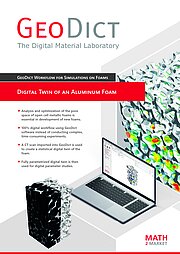Characterize Microstructure
MatDict
The MatDict module, along with the PoroDict module, can analyze the characteristics of porous media, whereby MatDict is used for the analysis of the material. MatDict is used to calculate material characteristics of 3D models obtained from CT-, µCT-, or FIB/SEM-image data or generated with GeoDict.
Examples of Applications
- Determine the individual and average coordination numbers of e.g. grains in rocks
- Characterize the grammage of new designed filters
- Perform connectivity checks on the material of interest by identifying the number of connected components
- Characterize materials which are used in batteries (anode and cathode)
Structure information
Porosity, solid volume fraction (SVF), the number of GAD objects, density, mass and grammage can be determined in all three spatial directions. The values are the average for the entire material(s) inside the bounding box. The individual solid volume fraction (SVF) of all materials can be found as well.
Connected components
This method analyzes the voxel to voxel relations of the solid material and defines the components that built up the solid fraction, resulting in information about the number of defined components (material and background), the mean number of components per 2D slice in each spatial direction and their size with respect to volume visualized as a histogram.
2D-Statistics
The algorithm calculates the distribution of grammage, solid volume fraction (SVF) and the number of objects in each plane to the direction of interest. Every pixel in this plane is calculated by averaging the respective property in the direction of interest.
Analyze Objects
The algorithm studies GeoDict Analytic Data (GAD) to obtain the total number of GAD objects, the number of overlap objects, the number of objects, the overlap volume percentage, the total number of contacts, the mean coordination number and the individual volume of each component. Histograms for object volume and contact area are provided.
- The GeoDict Base package is needed for basic functionality.
- ImportGeo-Vol: is needed to import and segment µCT images and create the structure models for analysis.
- Modules of Digital Material design to create 3D structure models in GeoDict






